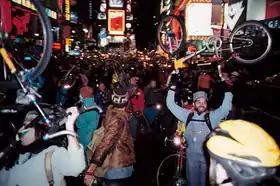
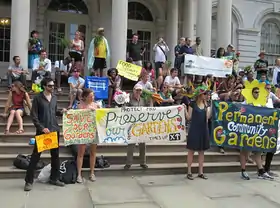
Time's Up! Environmental Organization was founded in 1987 to help educate New Yorkers about environmental awareness.[1] One of its main focuses is to promote non-polluting transportation, by advocating bicycling.
Time's Up! helped found New York City's Pedicab industry and took a role in maintaining community gardens in New York City.
More recent initiatives include support for the Occupy Wall Street movement and the Museum of Reclaimed Urban Space. Time's Up! is run by volunteers, with over 150 in 2012.[2] Time's Up! also had a video documentary team. Dr. Michael Nash, the director of Tamiment Library, wrote: “Time's Up has been at the center of a new generation of activist politics in New York."[3]
History
Early years
1987 Time's Up! Environmental Group was founded in New York City.[4] The group is committed to improving the environment by empowering individuals to become active participants in their communities. The first campaign introduce New York City residents to the connections between everyday choices and purchases and environmental issues such as rainforest destruction, animal testing, energy consumption, air quality, and water pollution through a series of highly visible.[5]
1988 Time's Up! partners with other environmental organization to ban styrofoam and reduce harmful chemicals that destroy the ozone layer.[6] The campaign to ban styrofoam started in the late 1980s. In 1987, Friends of the Earth, a group based in Great Britain, started focusing on boycotting McDonald's in an effort to get them to stop using their “clamshells” made from polystyrene foam packaging. McDonalds fought back against the campaign, and there was a call for all the environmental groups to work together, which Time's Up joined in 1988. In 1989, the Environmental Defense Fund had several meetings with McDonalds and came up with a plan to replace the clamshell with paper packaging. McDonalds finally banned it in 1991. Other fast food chains followed suit, some even came up with more sustainable practices for packaging food and drinks.[7]
When researching the negative effects of styrofoam packaging, Time's Up discovered that CFCs (chlorofluorocarbons), which were used during the making of styrofoam, were slowly destroying the ozone layer; this then became an even more urgent campaign focus. Time's Up teamed up with Greenpeace to let people know about these harmful effects. Eventually, CFCs were banned worldwide and replaced with HCFCs and HFCs, which were believed to do less damage to the ozone layer.[7]
At one point, Time's Up had posters all over the city about styrofoam packaging ("just say no to styrofoam" was one of our big slogan). The campaign was clearly working and people were shying away from styrofoam. But eventually, the styrofoam containers started showing up again in the late 90's. Finally, on July 1, 2015, New York City banned styrofoam.[7]
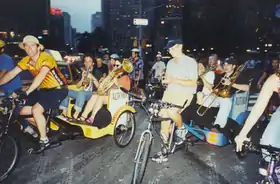
1991 Time's Up! launches a major campaign to promote non-polluting transportation, focusing on hybrid-electric and electric-pedal-assist technology. Time's Up Environmental Organization pioneered sustainable. non-polluting transportation for urban cities. The group teamed up with Light Wheels, Cooper Union and the HUB Station to conduct technological research and create early prototypes. In addition, Time's Up educated everyone from students to auto show attendees about alternative modes of transportation through workshops, seminars, and presentations. Many of these early concepts and prototypes can be seen on the streets today as seen in the posters.[8]
1992 Time's Up! supports the creation of the first Green Apple Map,[9] pinpointing 145 local sites in New York City that have environmental impact and sparking a local-global movement. The non-profit Green Map fostered the creation of locally led Green Map projects in over 400 cities in 50 countries. As of 2007, more than 325 separate Green Maps have been published, including five citywide editions of NYC's own map.[10] Time's Up! co-sponsors annual Green Apple Cycling Tours[11] that introduce the map's highlighted areas. These fun and informative rides encourages new riders and inspire them to work toward a greener New York City.[7]
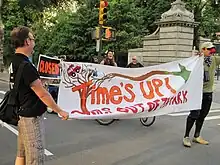
1993 Time's Up launches campaigns create sustainable auto-free urban design. This project began with regular traffic calming rides in Central Park and then expanded to help design and advocate for sustainable green infrastructure. This was done through the introduction of greenway rides, street parties, and urban planning and green design competitions. Some of these designs became widely accepted and can be seen on the streets today. For example, the West Side Greenway, pedestrian and bicycle bridge access, bicycle lanes, and auto-free pedestrian plazas in Times Square. Traffic calming rides[12] promote shared road use with bicyclists, skaters and pedestrians, with the goal of car-free parks and bike-friendly city streets. These rides have since spread to other boroughs and to other cities, raising awareness about the importance of clean air and safer public spaces.[7]
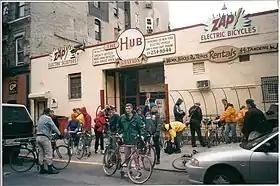
1994 Time's Up! supports the start of the Pedicab Industry in New York City. Working with the HUB Station, Time's Up! designs, assembles, and introduces 12 original pedicabs (bike powered cabs) to the streets of New York as a carbon-dioxide-reducing alternative form of urban transportation. Due to the tireless efforts of Pedicabs of New York, Manhattan Rickshaw and other environmentalists, the industry has since expanded to over 1,000 traditional pedicabs and electric-pedal-assist pedicabs in NYC alone, and inspired similar pilot programs in other cities. To date, pedicabs have produced over 2,000 green jobs in the city.[7]
According to the EPA's carbon calculator, the average New York Taxi emits 100,000 pounds of carbon dioxide each year. If 100 people who regularly take a taxicab each day choose to take a pedicab, around 10,000,000 pounds of carbon dioxide emissions are reduced.[7]
1994 Time's Up! monthly year-round Central Park Moonlight ride begins. It was very dangerous to ride in the streets of New York City so Time's Up turned to Central Park as a safe auto-free location to build biker confidence. The Central Park Moonlight Ride offers cyclists a safe, fun way to explore the park at night. A great draw for tourists, night-owls, lovebirds and regulars, the Central Park Moonlight ride recently celebrated its 23rd anniversary. Since its inception, night-time activity has surged in the park, and car-free hours have greatly expanded.[7]
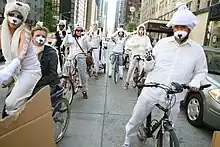
1995 Time's Up! introduce its first monthly calendar of free group bike rides and events to raise environmental awareness in fun, positive settings.
- These rides attract cyclists at all skill levels and socioeconomic classes, fostering a sense of community while highlighting the benefits of non-polluting transportation. The number one complaint from cyclists is that they didn't feel safe on their bicycles. The group rides created a safety bubble and helped build the confidence of new cyclists and inspired them to become everyday commuters.[7]
- The increase in riders puts more pressure on the city to create a safer infrastructure that, in turn, produces even more rides.[7]
- In fact, these group bike rides helped to increase cycling in New York City by over 100% from 2000 to late 2007. This was a time when New York City was not supporting cycling in any way with safe infrastructure. The increase in ridership and direct action pushed the city to alter the city's urban design and appoint a new Department of Transportation Commissioner who implemented bike lanes, auto-free zones and sustainable infrastructure in 2008.[7]
- Each new bicycle commuter created by these rides saves 2.82 tons of CO2 on average per year by cycling rather than taking a taxi (from carboncalculator.com). Time's Up! rides and events have gained international recognition, they've been featured and received several “Best Of” awards in publications such as The New York Times, The New Yorker, Time Out NY, and The Village Voice. Many of these unique rides have been replicated in other cities.[7]
1996 Time's Up teams up with Wetlands Activism Collective[13] to launch a campaign to raise awareness about animal rights and the preservation of both virgin forest and rainforest ecosystems. Special thanks to The Body Shop Anita Roddick who lent pictures and helped with the campaign to stop animal testing. Time's Up! continues collaborating with Wetlands on various events to date, including our weekly Thursday Night Movies and Presentations.[7]
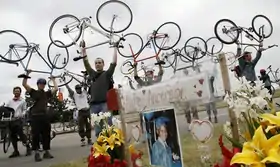
1996 Time's Up! pioneers the Street Memorial Project, commemorating cyclists and pedestrians killed by motorists.
- The Street Memorial Project creates silent but powerful memorials to draw attention to pedestrian and cyclist fatalities around the city through actions such as Stencil Memorials, Memorial Bike Rides, and candlelight vigils.[7]
- In collaboration with Time's Up! volunteers identify intersections around the city that are especially dangerous to cyclists and pedestrians.[7]
- Captured by the media, these actions successfully raised public awareness on the need for the improvements in the design of intersections, the creation of new bike lanes and motorist awareness campaigns, and harsher punishment of hit-and-run offenders. This project has been vital to increasing non-polluting transportation because it enables cyclists to fell safer utilizing shared roadways.[7]
- The success of this project in New York City has inspired similar programs in other cities including Chicago and San Francisco.[7]
- Later this project also took on “Ghost Memorials,” which are white bicycles placed in spots cyclists were killed by vehicles, now prevalent in cities nationwide.[7]
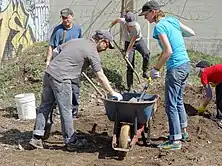
1997 Time's Up! teams up with the Lower East Side Collective's public space division to protect and celebrate use of public space, especially community gardens. Together, volunteers organize demonstrations, community garden cleanups, street parades, and events related to reclaiming public streets and parks for community use. Volunteers help clear rubble-strewn lots and establish new green spaces, cultivating a connection with the earth and the community. Time's Up! continues to highlight the environmental benefits of green spaces by leading bike tours to various community gardens.[7]
1997 Time's Up! celebrates its 10th anniversary. Time's Up! grows to over 50 volunteers, who coordinate a variety of environmental campaign and events from community garden cleanups to raising global awareness about climate change. Time's Up! continues to build its reputation for leading effective grassroots campaigns: increasing environmental awareness, promoting non-polluting transportation, defending cyclists’ rights, and protecting and creating green public spaces. Their techniques and campaigns become models for newly created programs to initiate environmental change around the world. [7]
1997 Time's Up! registers as a 501c3 non-profit corporation in New York State. Now that Time's Up! is an official non-profit organization, you can make your tax-deductible donation. Time's Up! is run 100% by volunteers, and all donations go directly into campaigns and events.[7]
1997 In collaboration with many organizations, Time's Up! rallies public support for the building of greenways to increase non-polluting transportation and public water access.
- Working in collaboration since 1997, Time's Up! and the Cherry Tree Association advocate increased public waterfront access in the Bronx. Together, these groups raise awareness about environmental injustice, including the relationship between air pollution and the high asthma rate in the Bronx.[7]
- In 1999, Time's Up! helps launch Friends of Brook Park, a group that has expanded environmental outreach work in the Bronx to include canoe and bicycle excursions for all ages. These efforts have seen great success with the plan for a Bronx greenway system, slated for completion by 2009.[7]
- Time's Up! and the Manhattan Waterfront Alliance continue to work with community and environmental groups to eliminate gaps in the car-free greenways, moving toward the ultimate goal of a continuous public greenway system around Manhattan, providing ample public waterfront access for pedestrians and cyclists.[7]
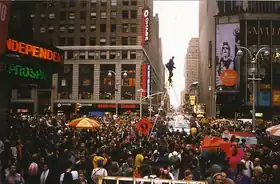
1988 Reclaim The Streets, which started in England, is a way drawing attention to the fact that the urban design of cities was not only meant for cars, but for the community. This was done through direct action, art, and dance. This Reclaim The Streets campaign was very successful in Europe but was more difficult in America because the police had no patience for community-style events and street closings. However, in NYC from about 1998 till 2002, there were several Reclaim The Streets events; the first at Astor Place Cube, which took over Broadway and created a street rave for over 4 hours.[7]
Another Reclaim The Streets event took place on Ave A/7th St, not only focused on reclaiming the street but also on taking over abandoned lots and turning them into vibrant community gardens. And of course, Reclaim The Streets took over Times Square and helped make it into a pedestrian plaza. There was even a Reclaim The Streets dance party in Williamsburg, Brooklyn on Bedford Ave.[7]
New York City Reclaim The Streets was loosely organized by anybody who wanted to dance and help reclaim the streets but also had help from the lower East Side Collective and Time's Up! Environmental Organization.[7]
1998 Time's Up! introduce its acclaimed video documentary team. The effectiveness of Time's Up! events and campaign can now be easily viewed worldwide.
- Time's Up! documents both environmental abuses and solutions. These videos show how communities unite to bring about sustainable change for a greener and more just New York.[7]
- Time's Up! Video Collective team continues to flourish and is noted for their fearless, truth-seeking front line footage, which is regularly screened on Manhattan Neighborhood Network, shared with independent media, and used to protect first amendment rights in legal proceedings.[7]
- From Community Board Meetings to major broadcast news stories to film festival, the Time's Up! Video Collective's footage promotes community activism in support of a sustainable New York.[7]
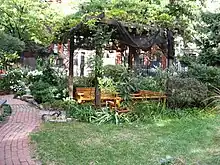
1999 Time's Up! has helped to save over 500 endangered community gardens. Time's Up! helped save over 500 community gardens throughout New York City through lobbying public officials; organizing and educating communities about the importance of community gardens; drawing press attention; creating visual aids (including colorful puppets and props); and encouraging non-violent direct action (including lockdown encampments and protests). The overwhelming success of these tactics has fostered similar grassroots movements for community gardens in cities across the country.[7]
One particularly notable clash between community organizers and the city took place at Esperanza Community Garden on East 7th Street. The city had plans to raze the garden and seize the land for a new housing development. Activists occupied the garden around the clock to stop its destruction. The More Gardens Coalition, community members, and TIMES UP! environmental organization helped spur a campaign to save the garden, which attracted activists from across the country.[7]
When the city came to demolish Esperanza Community Garden on February 15, 2000, over one hundred people gathered to defend it, with many chaining themselves to cement blocks and other objects to buy time as lawyers and activists descended upon the state courthouse to request a temporary restraining order that would prevent the impending demolition. Unwilling to wait for the judge's order, the city went ahead and demolished the garden; most of the activists were arrested.[7]
Infuriated by the city's refusal to wait for his ruling, Judge Richard Hutter responded by granting a temporary restraining order which protected all remaining gardens citywide. This allowed time for a permanent deal to save most of the remaining gardens, brokered by then-New York State Attorney General Eliot Spitzer. The so-called Spitzer Agreement remains in force today.[7]
1999 Time's Up! is granted 501(c)(3). Donations are now tax-deductible and can be made through the website or mail.[14]
2000s and beyond
2001 Time's Up! teams up with NYC Green Thumb Archived 2020-08-10 at the Wayback Machine and Trust for Public Land, to sponsor dozens of educational workshops and community garden cleanups. Time's Up! uses its large volunteer base to organize local communities to improve and protect existing gardens and to cultivate new gardens on vacant lots. With community support and the support of Green Thumb and Trust for Public Land, many of these gardens have now become permanent. The Time's Up! Garden Committee continues to fight for and supports all NYC community gardens.[7]
2002 Time's Up! works with the Clearwater Environmental Organization to promote cleaner air and water and cultivate the idea of Valet Bike Parking. Valet bike parking, which was pioneered by Time's Up, spread to hundreds of events in NYC and can now be seen on a global scale.[15] Time's Up! encourages festival-goers to ride their bicycles to the yearly Clearwater Hudson River Revival Festival, the region's premier environmental festival, by providing free "valet bike parking" and running an outreach environmental center. Growing steadily each year, the valet bike parking area served 200 people at the 2012 festival and has inspired other events to include provisions for people arriving by bike. Time's Up also partnered with ClearWater to shut down the ageing Indian Point nuclear power plant. Their efforts helped protect the Hudson River from the power plant's polluting effects.[7]
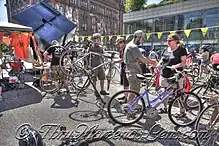
2003 Time's Up! leads the coordination of Bike Summer, a month-long celebration of bike culture in NYC. Consisting of more than 100 well-attended events from June to July, Bike Summer marks the first major collaboration among the city's numerous bike groups, contributing to an increased number of commuter cyclists and galvanizes an identity for the bicycle community that still exists today. Following its success, Bike Week, an annual event co-sponsored by NYC DOT, expands to New York City Bike Month.[7]
2004 Time's Up! supporter Steve Stollman generously donates full-time use a storefront space, centrally located at 49 East Houston Street, just east of Broadway, in downtown Manhattan. The Time's Up! space becomes a center for environmental education and enables Time's Up! to expand its indoor educational programs to include weekly seminars, guest speakers and movie nights. For the first time, internships can be offered, benefiting local and international university students.[7]
Hands-on workshops are offered in bicycle repair and welding, video editing, stenciling, composting, textile work and prop-making for events.[7]
Since 2004, our volunteers have recycled more than 1,000 bicycles. Over 10,000 people have attended our bicycle repair workshops where Time's Up! has empowered individuals to maintain their own bicycles and to take a step closer towards becoming more sustainable citizens who utilize and advocate for this form of non-polluting transportation.[7]
2004 Time's Up! hosts the Bike National Convention (BNC)[16], drawing thousands of visitors from all over the world. The BNC, coinciding with the Republican National Convention, consisted of a monthly-long calendar of free educational events and direct-action events to highlight environmental issues on a national stage. The large presence of cyclists during the Republican National Convention resulted in a boost of political clout and motivated local officials to take cyclists’ concerns seriously.[7]
2004 Time's Up! steps up its campaign to defend New Yorker's First Amendment Rights. Since its inception, Time's Up! has been dedicated not only to protecting the environment, but also to defending the community's right to use and assemble in public spaces. Fueled by the suppression of First Amendment Rights during and after the 2004 Republican National Convention, Time's Up! unites with acclaimed civil rights attorney Norman Siegel, New York Bar Association, National Lawyers Guild, Assemble for Rights NYC, Radical Homosexual Agenda, 100 Blacks of Law Enforcement, FreeWheels, International Mobility Justice Project, and numerous legal observer and video journalists to defend the right to speak and assemble peacefully. Time's Up remains committed to these rights, the engages in fun campaigns to promote free speech and the right to assemble without applying for a permit. Currently, Time's Up is working with New York Occupy Wall Street and the NYC legal community to ensure these fundamental rights. Many law firms and individual lawyers have filed successful lawsuits[17] supporting the right to assemble, including protection for group bike rides.[7]
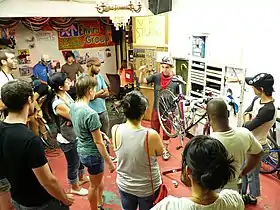
2004 Time's Up! media team is formed and external media coverage of issues and event involving Time's Up! rapidly increase over the years. Time's Up! continues to spread its message and promote its events to city-wide and even internationally. In the past year, events and campaigns run by Time's Up received over one hundred mentions in the media, including by major American outlets such as The New York Times, CNN, Voice of America, EI Diario NY, Bicycling Magazine, as well as from international media outlets in the United Kingdom and China.[7]
2005 Time's Up! begins working on the Ghost Bike Projects[18] in collaboration with the Visual Resistance art collective, which brought the concept of "Ghost Bike" memorial to New York City. “Ghost Bikes” – bicycles painted white with plaques above them to recognize deceased cyclists – are intended to honor cyclists killed on city streets and remind drivers to use caution and be aware of bicyclists. Time's Up! and Visual Resistance worked together in the placement of 38 ghost bikes around New York City at each known crash site where a cyclist was killed by a motor vehicle in 2005 and 2006. Along with Street Memorials Coalition, Time's Up! continues working on the Ghost Bike Project and for safer, more secure streets for cyclists and pedestrians.[7]
2005 Time's Up! begins organizing Holiday-themed bike rides and events to celebrate community. Time's Up recognized the increasingly corporate nature of many major holidays, such as Fourth of July, Halloween, Columbus Day, Valentine's Day, Christmas and New Year's Eve. These bike rides and afterparties transform the holiday into a more positive celebration of our history and our right to assemble and the importance of community holidays instead of corporate controlled holidays. Our New Year's Eve bike rides and afterparty is a positive celebration transforming the streets, hundreds of people come from around the world to participate in our New Year's Eve bike rides and afterparty, which ends in Central Park.[7]
2006 Time's Up! releases an extensive study prepared with economist Charles Komanoff to inform New York taxpayers of the monies spent by the city and state to suppress the monthly Critical Mass ride. The study calculated to financial cost to arrest, prosecute and bring suit against[19] law-abiding cyclists on this traffic group ride (which is replicated in hundreds of cities around the world). In addition to being covered in major media outlets, the study is referenced in the NYC Bar Association's statement opposing new NYC parade permit regulations.[7]
2007 Time's Up! teams up with New York University's Sustainability Taskforce to promote non-polluting transportation and environmental education among the NYU student body. In a project known as "Bike to School".[20] Time's Up! volunteers remove abandoned bicycles from NYU buildings, refurbish them, and redistribute them to students; design bicycle-parking infrastructure on campus; and educate incoming freshmen, enabling them to become bicycle commuters. This groundbreaking program set a precedent for the way bicycles can be recovered, recycled and respected in New York. Many privately owned spaces are now using these strategies and sustainable design.[7]
2007 Time's Up! celebrates two decades of initiating environmental change. Non-polluting transportation and environmental awareness are at an all-time high and the strength and success of Time's Up! continues to rise in New York City. With dozens of successful campaigns that have been replicated across the country, Time's Up! currently has more than 100 active volunteers who create and coordinate hundreds of free environmental events, bike rides and campaigns each year. Time's Up! now has a worldwide network of more than 5,000 friends and supporters working for positive environmental change, and we encourage you to become part of our community![7]
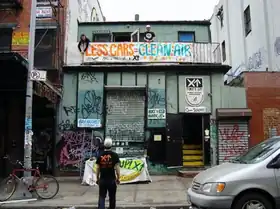
2008&2009 Time's Up! Introduced themed public space awareness events including dance rides and fountain rides and expands its fun and theatrical division focusing on reclaiming public space, and helping to create a safer, more livable city. Through the introduction of fountain and dance themed bike rides, Time's Up volunteers increase New Yorker's awareness of their right to reclaim public space. This strong message was a crucial precursor to the creation of the city's various pedestrian plazas around the city.[7]
This is a continuation of our “Reclaim the Streets” campaign, which we started in 1998 in New York City with huge sound systems and dance parties in the middle of public streets. We have transitioned these dance parties to mobile transportation– on our bikes. Time's Up Fountain Rides, Dance Rides, and Clown Rides helps to remind New Yorkers that many fountains and plazas are “privately owned public spaces” or POPS that developers built as part of a real estate deal. Since these “bonus plazas” are truly public spaces, Time's Up initiates dance and fountain rides to reclaim the spaces and make them accessible to the public. The purpose of these rides are to show that public spaces belong to the public and can be used as a gathering place, meeting place, dancing place, and a place for people to enjoy themselves without the ever-present danger of the automobile.[7]
2009 Time's Up! refocuses on Climate Change and holds a seminar at Klimaforum, the global civil society counterpart to the Copenhagen UNFCCC (United Nations Climate Change Conference). Times’ Up worked on dozens of local campaigns to call attention to energy use and climate change. While continuing our work on promoting non-polluting transportation and renewable energy, such as wind, solar, wave and geothermal power, and human power, we also started several campaigns to educate people on unsustainable energies and their dangers. These include nuclear, oil, and coal. We also spent a great deal of time holding workshops, seminars, and events on new technologies and continuously alerting communities of harmful new energy sources such as fracking, tar sands, and mountaintop removal.[7]
In 2009, Time's Up volunteers traveled to Copenhagen to participate in the Klimaforum09, a counterpart forum to the United Nations Climate Change Conference. Time's Up held a seminar on how the group uses tactics, campaigns, and direct actions to alter New York City's path towards a more sustainable design and greater respect for the environment.[7]
2010 Time's Up! opened its Williamsburg Brooklyn location. For years, Time's Up! campaigns have focused on new ridership. Keeping the bridges open for riders from Manhattan to Brooklyn has been a major challenge to our organization. The Williamsburg Bridge has the highest number of new riders crossing it and new ridership continues to flourish in Williamsburg. By opening this location right under the Williamsburg Bridge, along with our Manhattan location, we are able to support riders on both sides of the bridge. Our Brooklyn location offers a 24 hour bike vending machine, bike classes and workshops that have empowered over 20,000 people, thousands of low-cost recycled parts, a recycle-a-bike program, a Dutch bike program, a Hasidic lending library, and many other campaigns to help non-polluting transportation flourish.[7]

2010 Time's Up! introduce low cost Dutch bikes to its Brooklyn spaces. In the U.S, biking is often viewed as a sport or mode of exercise rather than a mode of transportation. Time's Up! hoped to change that by advocating for Dutch style bicycles in NYC. Dutch style bicycles are gender non-specific bicycles with large rear baskets, kickstands, full chain guards, and full fenders. They are suitable for riding in the rain and the upright design is safer to ride in traffic because it makes the rider more visible than other models.Time's Up started a recycle-a-bike program, which sought to make Dutch style bikes more readily available in the city in the hopes that these bikes would appeal to commuters. Time's Up sold these bikes at a very low cost, at around $100 each. This program was highly successful – after seeing the Time's Up Dutch bikes on the streets, New Yorkers demanded similar styles from other bikes stores across the city, and the sale of Dutch bikes skyrocketed. This strategy helped transform the American conception of biking from an athletic endeavor to an accessible, practical, and safe form of transport. Today, millions of New Yorkers make use of Dutch-style bicycles, riding them across the city's increasingly expansive greenways and bike lanes.[7]
2010 Time's Up! Created Their Own Energy Bikes. Time's Up! volunteers designed energy bikes that produce mechanical energy through the power of pedaling. These energy-producing bikes received national attention in the Occupy Wall Street movement. Time's Up! produced shorts videos on how to make your own energy bike. Thanks to support from Annenberg Foundation, Occupy Wall Street and Ben and Jerry's, Time's Up were able to produce these bicycles not only for NYC but in other cities as well.[7]
2010 Time's Up! starts organizing a weekly volunteer garden green-ups. Time's Up! began coordinating volunteers to visit different community gardens around NYC each weekend to help with garden maintenance, and planting projects.[7]
2011 Increased education on the harmful effects of natural gas fracking and nuclear power. Times Up! hosted extensive educational campaigns about the harmful effects of natural gas fracking and resulting water contamination. This year we also increased awareness and education about the Alberta tar sands and the potential harmful future effects caused by the proposed gas pipeline. We also worked with several campaigns focusing on the harmful effects of nuclear power and launched a campaign to shut down Indian Point power plant.[7]
2011 Involved with the Occupy Wall Street Movement. When the Occupy Wall Street Movement began in September 2011, Time's Up was quick to get involved. Many volunteers were regular occupiers, and others took the lead on the movement's sustainability committee. One of the most substantial of Time's Up's contributions was the introduction of energy bikes as a clean-energy alternative to gas generators in Zuccotti park. Time's Up secured $15,000 from NYCGA and CrowdRise to build 14 energy bikes in the park, each of which was able to produce 100 amps of power. This effort was met with frequent sabotage attempts by the NYPD, who raided the park on November 15. The police confiscated many of the energy bikes, destroyed others, and arrested one of Time's Up's volunteers. Within the next few weeks, some of the energy bikes were recovered and were put back into use. Widespread media coverage of the NYC Occupy Wall Street movement also shared visuals of the energy bikes nationally. When different cities began their own versions of Occupy Wall Street, the spaces were equipped with energy bikes. This helped to further spread human power as a viable and sustainable form of power for activist efforts around the world.[7]
2011 Time's up! rents space at greenmap system NYC where it begins archiving its history and collecting videos, pictures and texts from sustainable grasswoods campaign in NYC. Working with the Time's Up video team and photo documentarians 7 days a week, we were able to copy and scan videos and pictures which not only were preserving the history but also were used in many court cases to defend activists and pass sustainable legislation. The archivists team was led by Barbra Ross, Alley Ryan, and Chris Ryan. The archiving space started at Time's Up on Houston St. then moved to Greenmap and now is continuing at the Museum of Reclaimed Urban Space.[7]
2012 Time's Up! activist efforts are recognized in an exhibit at the Museum of the City of New York. Time's Up helped curate a portion of the exhibition at the Museum of the City of New York, which highlighted the bicycle revolution in NYC. Time's Up donated images, videos, and text documents that showcase the activist work that fueled the growth of the cyclist movement, police attempts to repress the movement, and the eventual implementation of bike-safe infrastructure such as bike lanes, auto-free plaza, and greenways.[7]
2012 Launched the Museum of Reclaimed Urban Spaces. The Museum of Reclaimed Urban Space (MoRUS) opened, with the mission to preserve the history of grassroots urban space activism and archiving efforts to create community spaces. By displaying archival materials from Time's Up, this innovative museum shows visitors how East Village community members and grassroots organizations stepped up and helped transform abandoned buildings and vacant lots into vibrant community spaces and thriving community gardens. Many of these grassroots, sustainable efforts spread to communities outsides the neighborhood and can be seen today throughout the world. Bill Di Paola explained in an article in Time Out Magazine. "People can get involved in their community and make proper choices about what they buy. The solution is all around us. We don't really need a revolution. We just need to support things that already work.” The museum is located on the ground floor of historic C Squat in 155 Avenue C, between 9th and 10th Streets.[7]
2012 Hurricane Sandy Relief Efforts. After Hurricane Sandy ravaged the East Coast in the fall of 2012, Time's Up collaborated with the Museum of Reclaimed Urban Space to provide immediate disaster relief in the Lower East Side, the hardest-hit area of downtown Manhattan. The morning after the storm, the organizations jumped into action, giving out hot meals and helping bail out water from local businesses. The power was out in much of the city, and Time's Up made energy bikes available for people to charge their phones and other small electronics. For the next several weeks, Times’ Up and MORUS organized small volunteer teams to travel to Staten Island and the Rockaways (the hardesthit areas in the city) to bring energy bikes, food, and other supplies to folks in need. Time's Up disaster relief efforts are well known for being quick to respond and utilizing low-tech methods.[7]
2013 Time's Up! partners with the Museum of Reclaimed Urban Space with sustainable walking tours and sustainable school programming. Primary school and college students are involved in weekly walking tours focusing on sustainable urban design and learning the grassroots history of community gardens. These tours and educational classes learn about recycling, composting, water recovery systems, food-growing techniques, medicinal gardens, solar systems, and a lot more.[7]
2015 Time's Up! Travels to Paris during the COP21 for Presentation at 'The Climate Action Zone'. Time's Up presented a multimedia presentation and question and answer session at ‘The Climate Action Zone’ in the CENTRQUATRE during the last week of COP21. The presentation covered how sustainable grassroots community projects have ignited social change and policy change in NYC. The presentation also included videos about different sustainable subjects, including bicycle activism efforts in NYC, energy bikes, and community garden renovation. Time's Up also helped with banner and prop making and helped organize for the big celebratory march to the Eiffel Tower. This climate conference resulted in the progressive Paris Agreement, which on Earth Day in 2016 was signed by 174 countries.[7]
2016 Time's Up! Introduce Outdoor Bike Repair Classes and Water Recovery System in La Plaza Community Garden. Time's Up has always collaborated with La Plaza community garden located on the SW corner of 9th Street and Ave C, which is one of New York City's more sustainable, event-based gardens. In 2017, we helped to increase their sustainable systems and added more workshops, such as a weekly bike repair class and composting class. We also helped to design a rainwater recovery system that was implemented in the garden. To this day, Time's Up continues to partner with the garden, helping host community events for all ages and activist efforts.[7]
2017 Time's Up! steps up its community garden campaign. Time's Up steps up its maintenance of New York community gardens by using social media to attract new volunteers to help with green ups and to support their local community gardens. This resulted in more green-up days with more volunteers and we were even able to plant over 50 trees in 2017. We also worked with the Museum of Reclaimed Urban Space to start a new medicinal garden and partnered together to work on a campaign to make the Lower East Side the neighborhood with the highest concentration of community gardens in Manhattan.[7]
2018 Central Parks & Prospect Park became auto-free. Central & Prospect Park loop roads finally became auto-free after a 20-year-long campaign that included over 100 direct actions. This was a big victory not only for the two parks, but also for other East Coast parks, which began to follow their lead in implementing auto-free policies. Time's Up played a big role in these campaigns, organizing large traffic calming rides through Prospect and Central Park.[7]
2018 Time's Up! Celebrate Its 30th Year with a Future Positive New Year's Eve Party. In 2018, Museum of Reclaimed Urban Space celebrated its 5th anniversary and Time's Up celebrated its 30th anniversary. To commemorate this milestone, volunteers ran a Future Positive New Year's Eve Party, which highlighted positive environmental changes. These included the designation of Prospect Park as officially and permanently auto-free, which Time's Up helped campaign for, and updates on the hole in the Ozone layer, which began to slowly repair itself after CFC emissions were brought down. Time's Up and MORUS want to thank the thousands of volunteers and financial supporters who have helped us actualize these changes.[7]
2019 Time's Up! presents its first international show in Paris, France, "Community Gardens, New York to Paris: Culture Transatlantiques". New York City's gardens were saved by direct action from community members and groups like Time's Up! and the More Gardens Coalition. Today, these gardens are mostly run by volunteers, and are not only vital in building community, but also teaching people about sustainable urban practices. Time's Up! teamed up with our partner, the Museum of Reclaimed Urban Space, to create a multimedia presentation and direct action for the “Cultures Transatlantiques” event that showcased the similarities between the histories and struggles of New York City community gardens compared to those of Paris, France. Programs included a pop-up community garden situated beneath a rail track (la Promenade Barbès La Chapelle) featuring several volunteer-made planters, as well as a poster and photography exhibition supplemented by lectures, speaking engagements, and a discussion. Special thanks to all the volunteers in Paris, and our two curators from MoRUS (Claire Duvernet and Elise Prot)[7]
2019 Time's Up! Started the Honey Bee Workshop. Alarmed at the rapidly diminishing bee population across the world as the result of colony collapse disorder, Time's Up jumped into action to help support the bee population in NYC. The organization started a workshop to help teach community members how to introduce bee colonies in local community gardens and support pre-existing hives. During these workshops, Time's Up also educated participants on the importance of honey bees and helped spread awareness about this critical issue. [7]
2020 Time's Up! Works to Support the Community Amidst the COVID-19 Pandemic. In 2020, Time's Up! stepped up its community relief efforts in response to the COVID-19 pandemic by increasing cycling and sustainable infrastructure and creating more auto-free and pedestrian-friendly streets. They also increased both outdoor bike repair workshops to help facilitate post-pandemic recovery, including local food growing, honeybee workshops, and medicinal workshops.[7]
2021 Time's Up! Celebrates the Permanent Closure of the Indian Point Nuclear Power Plant. After an over 20 year campaign, Indian Point Nuclear Power Plant permanently shut down on April 30, 2021. Paul Galley, president of the environmental group Riverkeeper described the importance of closing the plant: “there are 20 million people living with 50 miles of Indian Point and there is no way to evacuate them in case of radiological release. And the risk of that is quite real.” Along with Riverkeeper, Time's Up collaborated with Clearwater and numerous volunteer community members to campaign for the plant closing. [7]
2022 Time's Up! Celebrate 35 years of environmental education and direct action. The same year, Time's Up's project, the MoRUS, also celebrated its 10-year anniversary with a week of celebratory events including a greatest hits outdoor film festival and a huge anniversary party at New Blue nightclub.[7]
2023 Time's Up! Celebrate 20 years of in-door bike repair workshops & classes.[7]
2023 La Plaza community garden installed its solar pavilion. Time's Up long-term partnership with La Plaza community garden helped to make it one of NYC’S most sustainable gardens. La Plaza volunteers helped install a solar pavilion under which community members can enjoy shade while the panels provide power to all the events held in the garden. With this addition, La Plaza boasts a sustainable water recovery system and medicinal garden, as well as weekly bike repair classes and composting workshops, and a plethora of other community-centered events.[7]
2023 Time's Up! celebrates 20 years of empowering people with bike repair and workshop. To date, Time's Up has held over 2,400 indoor and outdoor bike repair classes and workshops, which are 100% run by volunteer mechanics. These unique spaces were set up with a wide variety of tools and equipment, which community members use to empower themselves to fix their own bicycles and use tools. Our workshops’ indoor spaces included the Hub Station on 3rd Street, Light Wheels on Houston Street, the Hub Station on Morton Street, ABC No Rio on Suffolk Street, and the Time's Up Brooklyn space at 99 South Sixth Street. Now, Time's Up! has a new location at 626 E. 14 St. where we continue our indoor workshops, and our outdoor classes are being held mostly at La Plaza Community Garden. At one point, Time's Up! had spaces on either side of the Williamsburg Bridge, which supports, empowers, and encourages bicyclists, especially new riders. We would like to thank all the volunteer mechanics, community gardens, and landlords who gave us permission to use these spaces to empower the public. All our events, workshops, and classes are free, and to date, we have empowered 4,000 participants in our class and workshops.[7]
References
- ↑ Shepard, Benjamin (2014-04-30). "DIY Urbanism as an Environmental Justice Strategy: The Case Study of Time's Up! 1987-2012". Theory in Action. 7 (2): 42–73. doi:10.3798/tia.1937-0237.14010. ISSN 1937-0237.
- ↑ Rebecca, Fishbein (18 April 2012). "Where to volunteer in NYC: Environment". Time Out New York.
- ↑ Moynihan, Colin (November 7, 2009). "The Ephemera of Protests, Carefully Hoarded, Is Going to an Archive". The New York Times.
- ↑ "Time's Up! Timeline". Time's Up!. Retrieved 2012-10-01.
- ↑ Time's Up! Environmental Organization (2009-10-14), every time you shop, retrieved 2023-08-31
- ↑ Cook, Elizabeth (1990). "Global Environmental Advocacy: Citizen Activism in Protecting the Ozone Layer". Ambio. 19 (6/7): 334–338. ISSN 0044-7447. JSTOR 4313729.
- 1 2 3 4 5 6 7 8 9 10 11 12 13 14 15 16 17 18 19 20 21 22 23 24 25 26 27 28 29 30 31 32 33 34 35 36 37 38 39 40 41 42 43 44 45 46 47 48 49 50 51 52 53 54 55 56 57 58 59 60 61 62 63 64 65 66 67 68 69 70 71 72 73 74 75 76 "Time's Up! 35th Anniversary Timeline". Time's Up!. Retrieved 2023-08-31.
- ↑ Time's Up! Environmental Organization (2009-10-13), electric vehicles, retrieved 2023-08-31
- ↑ "GreenMap.org | Think Global, Map Local!". www.greenmap.org. Retrieved 2023-08-31.
- ↑ "New York City's Green Map | GreenMap.org". www.greenmap.org. Retrieved 2023-08-31.
- ↑ admin (2006-12-22). "Time's Up! - Green Apple Ride". Time's Up!. Retrieved 2023-08-31.
- ↑ admin (2006-12-22). "Time's Up! - Traffic-Calming Rides". Time's Up!. Retrieved 2023-08-31.
- ↑ "Wetlands Activism Collective". www.wetlands-preserve.org. Retrieved 2023-09-01.
- ↑ "Time's Up! 35th Anniversary Timeline". Time's Up!. Retrieved 2023-09-01.
- ↑ "Time's Up! 35th Anniversary Timeline". Time's Up!. Retrieved 2023-09-07.
- ↑ admin (2006-12-23). "Time's Up! - Bike National Convention". Time's Up!. Retrieved 2023-09-07.
- ↑ brandon (2007-02-06). "Time's Up! - Federal and State Judicial Victories". Time's Up!. Retrieved 2023-09-07.
- ↑ admin (2006-12-22). "Time's Up! - Ghost Bike Memorials". Time's Up!. Retrieved 2023-09-07.
- ↑ admin (2007-04-01). "Time's Up! - 2007-03-27 NYC Drops Lawsuit". Time's Up!. Retrieved 2023-09-07.
- ↑ rachel (2007-08-21). "Time's Up! - 2007-08-21 - Bike Reclamation - NY Times". Time's Up!. Retrieved 2023-09-07.
External links
- Official website
- Time's Up! Records at Tamiment Library and Robert F. Wagner Labor Archives at New York University